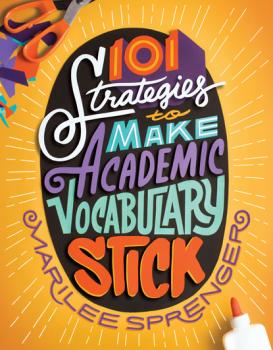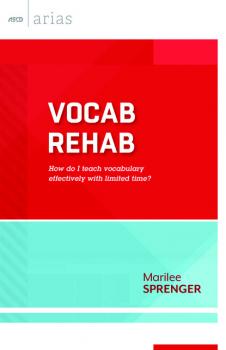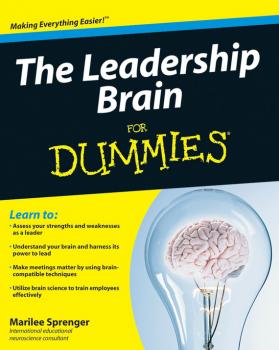ТОП просматриваемых книг сайта:
Marilee Sprenger B.
Список книг автора Marilee Sprenger B.Аннотация
Today's teachers face a daunting challenge: how to ensure a positive school experience for their students, many of whom carry the burden of adverse childhood experiences, such as abuse, poverty, divorce, abandonment, and numerous other serious social issues. Spurred by her personal experience and extensive exploration of brain-based learning, author Marilee Sprenger explains how brain science—what we know about how the brain works—can be applied to social-emotional learning. Specifically, she addresses how to- Build strong, caring relationships with students to give them a sense of belonging.– Teach and model empathy, so students feel understood and can better understand others.– Awaken students' self-awareness, including the ability to name their own emotions, have accurate self-perceptions, and display self-confidence and self-efficacy.– Help students manage their behavior through impulse control, stress management, and other positive skills. – Improve students' social awareness and interaction with others.– Teach students how to handle relationships, including with people whose backgrounds differ from their own.– Guide students in making responsible decisions.Offering clear, easy-to-understand explanations of brain activity and dozens of specific strategies for all grade levels, Social-Emotional Learning and the Brain is an essential guide to creating supportive classroom environments and improving outcomes for all our students.
Аннотация
Veteran educator Marilee Sprenger explains how to teach the essential, high-frequency words that appear in academic contexts–and reverse the disadvantages of what she calls "word poverty." Drawing on research and experience, Sprenger provides a rich array of engaging strategies to help educators across all content areas and grade levels not only teach students a large quantity of words but also ensure that they know these words well . You'll find An overview of how the brain learns and retains new words, including the three stages of building long-term memories: encoding, storage, and retrieval.Encoding strategies to introduce words in novel ways and jump-start the memory process.Rehearsal strategies to help students put words into long-term storage.Review strategies to help students strengthen their retrieval skills and gain the automaticity needed for reading comprehension.Ways to address planning and assessment as crucial, intersecting supports of a robust vocabulary program.This comprehensive resource has everything you need to help your students profoundly expand their vocabulary, enabling them to speak, read, and write with greater understanding and confidence.
Аннотация
Smartphones, videogames, webcasts, wikis, blogs, texting, emoticons. What does the rapidly changing digital landscape mean for classroom teaching? How has technology affected the brain development of students? How does it relate to what we know about learning styles, memory, and multiple intelligences? How can teachers close the digital divide that separates many of them from their students? In Brain-Based Teaching in the Digital Age , Marilee Sprenger answers these and other questions with research-based information and practical advice gained from her years as a classroom teacher and a consultant on brain-based teaching. As she puts it, «It's time to meet the ‘digital brain.' We need to use the technology tools, learn the digital dialogue, and understand and relate better to our students.» At the same time, she emphasizes the importance of educating the whole child by including exercise, music, and art in the classroom and helping students develop their social-emotional intelligence. Creativity, empathy, and the ability to synthesize material are 21st century skills that can't be ignored in the digital age. Readers will find easy-to-understand information about the digital brain and how it works, «high-tech» and «low-tech» strategies for everyday teaching and learning, and inspiration for creating classroom environments that will entice and encourage students at all grade levels. With this book as a guide, educators can move confidently across the digital divide to a world of new possibilities–for themselves and their students. Note: This product listing is for the reflowable (ePub) version of the book.
Аннотация
A collection of engaging 10-minute strategies for teaching content vocabulary across content areas.
Аннотация
Your students may recognize words like determine, analyze, and distinguish, but do they understand these words well enough to quickly and completely answer a standardized test question? For example, can they respond to a question that says “determine the point of view of John Adams in his ‘Letter on Thomas Jefferson’ and analyze how he distinguishes his position from an alternative approach articulated by Thomas Jefferson”? Students from kindergarten to 12th grade can learn to compare and contrast, to describe and explain, if they are taught these words explicitly. Marilee Sprenger has curated a list of the critical words students must know to be successful with the Common Core State Standards and any other standardized assessment they encounter. Fun strategies such as jingles, movements, and graphic organizers will engage students and make learning these critical words enjoyable and effective. Learning the critical vocabulary will help your students with testing and college and career readiness, and will equip them with confidence in reading, writing, and speaking.
Marilee Sprenger is also the author of How to Teach So Students Remember, Learning and Memory, and Brain-Based Teaching in the Digital Age.
Marilee Sprenger is also the author of How to Teach So Students Remember, Learning and Memory, and Brain-Based Teaching in the Digital Age.
Аннотация
Using the latest neuroscience research to enhance literacy instruction Wiring the Brain for Reading introduces teachers to aspects of the brain's functions that are essential to language and reading development. Marilee Sprenger, a specialist in learning and the brain, provides practical, brain friendly, strategies for teaching essential skills like phonemic awareness, phonics, fluency, vocabulary, and comprehension. The author's innovative approach aligns well with the Common Core State Standards for English Language Arts and is designed to enhance students' motivation and excitement in reading. Offers a clear explanation of brain functioning in order to enhance language and reading instruction Incorporates proven literacy strategies, games, and activities as well as classroom examples Aligns with Common Core State Standards for learning to read, developing fluency, and interpreting complex texts Wiring the Brain for Reading offers practical strategies for applying the latest research in neuroscience and learning to the classroom.
Аннотация
Discover how scientific knowledge of the brain can make you a better leader Based upon the latest breakthroughs in neuroscience and advances in brain-based education, Leadership Brain For Dummies gives you the edge to influence, lead, and transform any team or organization. Drawing concrete connections between the growing scientific knowledge of the brain and leadership, this book gives you the skills to assess your strengths and weaknesses as a leader, adopt a style of leadership that suits your characteristics, determine the learning styles of individual employees, and conduct training sessions that can physically change brains. The author is an international educational neuroscience consultant and an adjunct professor, teaching brain-compatible strategies and memory courses. She is a member of the American Academy of Neurology, the Cognitive Neuroscience Society, and the Learning and Brain Society Leadership Brain For Dummies provides practical, hands-on guidance for applying the information to make you a better leader The Leadership Brain For Dummies positions current and aspiring leaders to be at the very top of their leadership game.









